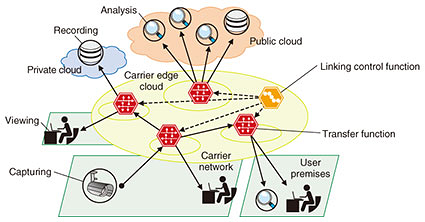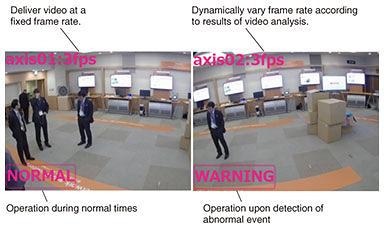 |
|||||||||||
|
|
|||||||||||
|
Feature Articles: Network Technology for Digital Society of the Futureˇ˝Research and Development of Competitive Network Infrastructure Technologies Vol. 17, No. 6, pp. 30–32, June 2019. https://doi.org/10.53829/ntr201906fa9 Data Stream Assist Technology Supporting Video TransferAbstractResearch and development is underway at NTT Network Technology Laboratories on data stream assist technology deployable in a lightweight and flexible manner to provide a network that can support complex services using high-functionality and high-performance Internet of Things (IoT) devices. As a specific use case, this article introduces technology that can vary communication protocol, timing, and volume to accommodate diverse types and uses of camera video and raise network usage efficiency while improving the convenience of use for IoT service providers. Keywords: edge computing, IoT services, video surveillance 1. IntroductionThe Internet of Things (IoT) has been spreading in recent years thanks to advances in video analysis using artificial intelligence and the expansion of broadband and high-speed communication circuits [1]. While security services for crime prevention and surveillance are typical video applications using cameras, increasing attention is coming to be focused on the use of video in differing applications such as in marketing for understanding customer purchasing behavior and in manufacturing for inspecting product appearance. In short, the purposes of using video are diversifying. 2. Difficulty of varying configuration of video IoT systemsWhen a video IoT system is implemented, it is common to construct such systems on the user’s premises. Doing so, however, makes it necessary to deploy dedicated equipment such as a media server, which makes it difficult to modify the system configuration whenever changes in the video application occur. The barrier to introducing video IoT is consequently high. Depending on the application, it may not be necessary to obtain camera video at all times. For example, there are few cases in which video needs to be continuously watched during uneventful periods but many cases in which it needs to be watched in the event of an abnormal occurrence such as an undesirable incident or accident in order to understand the situation. In such a scenario, obtaining video on a continuous basis may result in congestion on the user’s local area network. It may also cause congestion on the telecom carrier’s network in the case of remote viewing or analysis. There is therefore a need for dynamically changing to a configuration that obtains video only when needed. 3. Data stream assist technologyData stream assist technology is intended to solve the above problem by achieving network functions that can contribute to video IoT managed services. As shown in Fig. 1, this technology consists of two types of functions: a transfer function for transferring video streams and a linking control function for managing the transfer function [2]. These functions must follow design guidelines for lightweight software that can be combined with an existing video IoT system and deployed in a distributed manner. For this reason, we adopted Docker [3] as an environment for running function processes and Kubernetes [4] as a container orchestrator in a prototype system (Fig. 2) that we constructed. When a video stream is registered, the physical machines and areas to be used are declared so that containers in a standby state are deployed on each machine and stream management functions are launched for obtaining and transferring video media information. This is followed by actual delivery of video streams upon request from viewing devices as delivery destinations. In this way, it becomes possible to dynamically deploy necessary functions and to obtain only the video needed when certain types of events occur. This enables the flexible construction of a system even in an environment with limited network and computing resources.
4. Future outlookWe consider data stream assist technology to have high affinity with a multi-cloud environment that combines a carrier edge cloud* with public and private clouds. Our aim is to achieve rapid rollout of video IoT and high scalability by dynamically deploying network functions for efficient and safe delivery of video according to the video application.
References
Trademark notesAll brand names, product names, and company/organization names that appear in this article are trademarks or registered trademarks of their respective owners. |
|||||||||||















